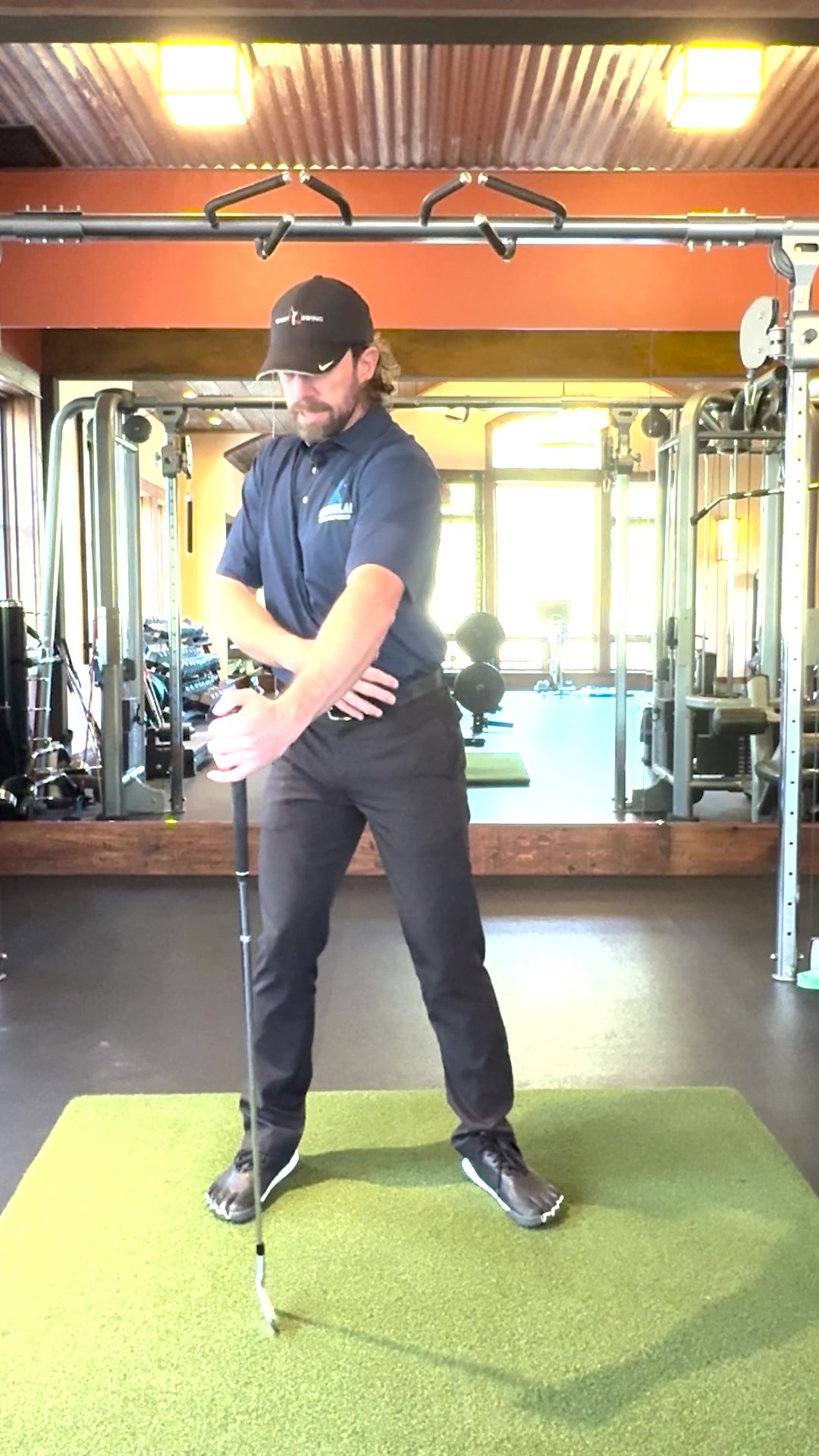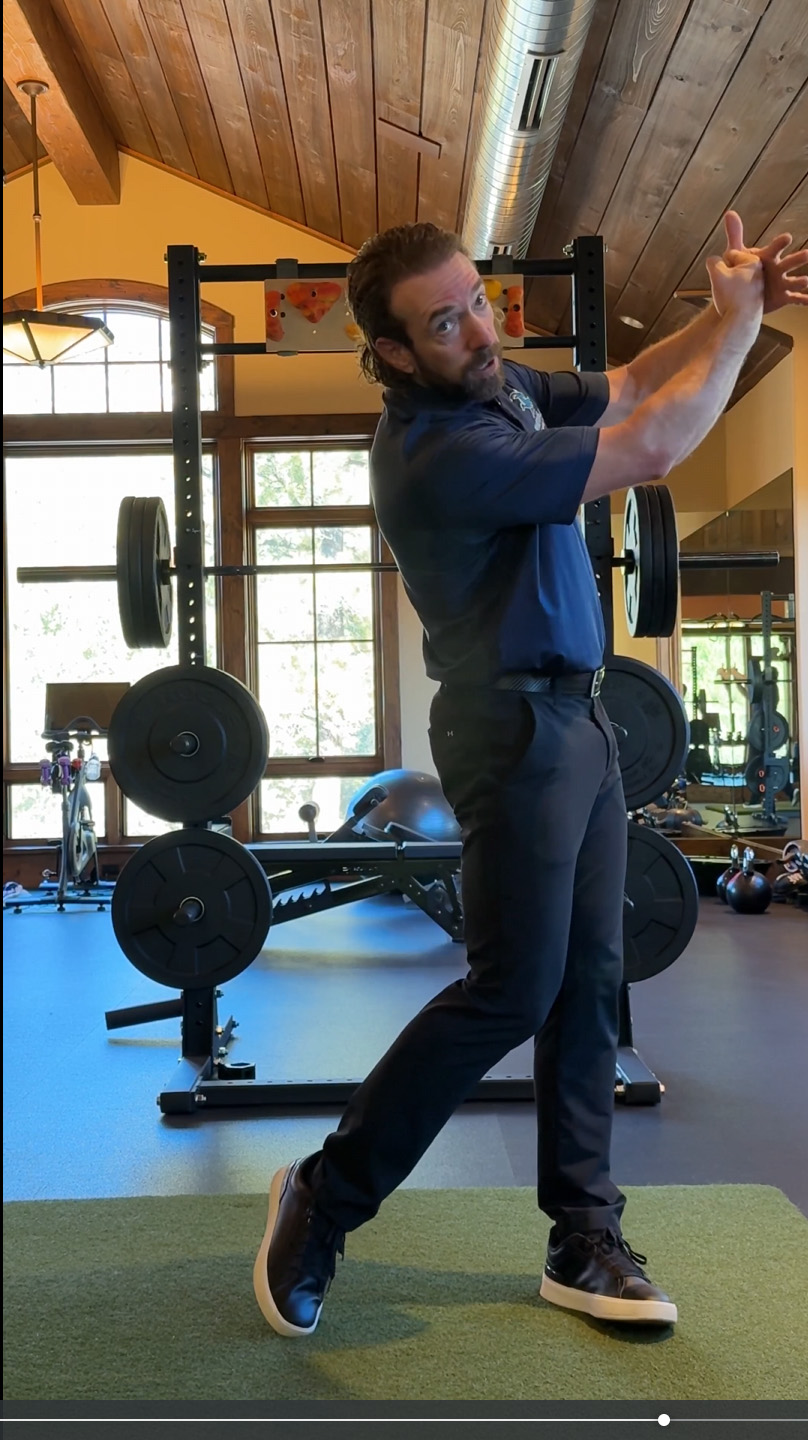Video Menu
My Favorite Videos
My Favorite Videos
The Magic Box - How to Check Your Lower Body in the Transition
Sorry, you need to be a member to access this video.
You Are Just Seconds Away - Become a member here!
Already a member? Log in now

The "Magic Box" is a term created by Chuck Quinton to help golfers learn the proper transition of the lower body in the golf swing.
all right guys I want to share with you a concept today that I'm going to be showing you in my own swing as I'm still in lockdown just like everybody else and showing you how the lower body works in the swing I'm gonna let this play for a second as I'm talking here for just a brief moment because I want to help you understand something that this concept that I call the magic box that I'm going to show you in just a moment is one of the things that actually in my opinion is probably the biggest thing that separates the tour pros from the handicap high handicap golfers the the great golfers from or the great ball strikers from the poor ball strikers the powerful ones against the weak ones it's all coming down to this and as you guys know in my opinion that the lower body movement is what really matters most in fact it's the first thing I look at in my student swings and Tiger Woods has always been a great example of how to move the core and the trunk the lower body and so I'm going to use him as an example today it's very easy to see that I'm going to show you in my own swing in an upcoming video how I'm working on this how you can work on it how it applies to the dead drill and how you can add power to your dead drill so what I want you to understand is that if the lower body movement is not correct then I don't care how anything else looks at the top of your backswing it's really easy to fake looking decent at the top it's easy to look like the clubs in the right spot but if it could all fall apart in the downswing if your lower body doesn't move correctly the muscles at that point that's where you can't fake it anymore the sequencing of the swing what muscles are loaded in what order how they're loaded how they unload and unwind in the downswing that's what separates the great ball strikers from the crappy ones and that's what I'm going to share with you today is this one simple concept that again I call the magic box and again there's nothing magic about it really it's just something that if you start getting your lower body to move correctly using the simple little check the magic box I'm going to share with you then it's going to make it so easy for you to understand when your swing starts falling off and getting out of the wrong right sequence so here's how you do it so obviously you guys indoors practicing right now so your video and your swings and you're posting up on the Facebook group that's awesome and I want you to do the same thing but I want you to do it with the magic box so now here's how you do it I want you to take a vertical line and draw it on the outside of your lead knee at the top of your backswing then draw one more vertical line on the inside of your trail leg knee at the top of your backswing and then if you want to make it a box this is your magic box now what this represents this is maximum range at the top this is how far your left knee is going to move forward you'll see in Tiger's case it moves out over the the toes of his left shoe here don't get too caught up on exactly where it is that is a great checkpoint there but I don't want you to worry so much about that right now it's more about what's happening after this in the downswing as we start down is what matters so what happens next now as you guys know in the dead drill sequence there's three core videos we do the backswing is one step the transition as another step and the post up move as the third step and if those body movements are correct then we start stacking on the arms and club and so on so in this case what we're really going to focus on is just getting that transition move the squat to square move you guys have heard me talk about so much what you'll notice as soon as Tiger starts his squat to square move now what is just as a checkpoint for you what is the checkpoint at the end of the transition well it's when the left arm and lead trail lead arm is about parallel to the ground right at that point where should your hips be just testing you guys here where should the hips be they should be about back to square now Tiger demonstrates this as well as anybody he's done the squat to square move he's obviously increased knee flex he squatted down more he's loaded up his glutes this is super important for power in the swing but as he's done this squat to square and got his lead arm back to parallel where are his knees notice that both knees are back in line and they're right in the center of the magic box and that's what I want you to check now if you look at your own swing right now you'll probably find that your knees both knees are nowhere near this point unless you're doing the squat to square move correctly and to do it correctly it involves several key components that I'm going to share with you in an upcoming video here soon in my own swing showing you how I'm practicing and working on this stuff in the gym because again you don't need to be outdoors doing this and we're going to talk about that counter torque move that I've talked about in the right foot when we're adding power to the swing and I know for a lot of you understanding this concept of when you can push and when you can pull pushing adds power to the swing think about if you if you get a car stuck on the side of the road you go back behind it and you start pushing it right you don't go to the front bumper start trying to pull it it's not as powerful for the body in the sequence that the way that our muscles and joints can align and move so the same thing is true in the swing pushing can add power to the swing as long as the lead sides moving correctly which in Tigers case of course you can see he's sitting into that left side left knee initiated it and then he's posting up on that left side he's using the right side to add power and speed to that and as long as you do it correctly and you check during the transition moves step two of the dead drill that your knees are back in the middle of that magic box then you are golden this is a simple checkpoint that's going to help you understand how your lower body is moving correctly and now in the upcoming video that I'm going to share with you showing me inside I'm going to talk about the exact movement of the weight how it moves in a figure eight pattern in the downswing how that right ankle moves in toward the left I we can zoom in on Tiger here just as a quick precursor to the upcoming video you can watch very clearly as the weight moves in the downswing it was over the left ball of foot then back over left ankle and hit and then the right foot it's going over the right ball of the foot and you'll see as he begins to push off that moves that right foot in towards the left and so now it's very easy to see that his left foot has now moved in this direction and we're going to talk about all that stuff in this upcoming video but for now I want you to just post your swings in the Facebook group or you can do this if you're getting a swing review an online lesson with us and start checking whether or not your lower body is moving correctly if your lower body moves correctly magic will happen that's why it's called the magic box your upper body will be falling into sequence your arms will be moving into sequence swing plane will take care of itself path will take care of itself but if your lower body's off and I promise you when you guys start looking at your swing and looking at where your knees are during the end of step two in the transition you'll be shocked to see that they're probably nowhere near the middle of that magic box but that's going to be the first thing that I want you to begin to check it's the first thing I look at my student swings if their lower body and core isn't moving correctly I don't give a damn where that club is at the top of the swing it's easy to fake this anybody in seconds can be manipulated into a position that looks good at the top but how you unwind and how your lower body moves in the muscles the way that they're loaded the way that you're moving in the right sequence is what separates a great ball striker from a cruddy ball striker and it all starts with the magic box so post your swings up in the Facebook group let us take a look we're gonna keep helping you guys in there and in your online reviews your swing reviews and then in a couple of days I'm going to share with you this next video where I'm going to talk about how to use your body how to do that counter torque move with the right foot to add pushing for power and for those of you that are not enrolled in the boot camp yet we still have a few more spots left in there I'm going to close off registration here shortly so make sure you click the link down the description if you want to get into boot camp and if you like this video please click the like button and subscribe down below





































































































































































































































































































































































































































































































Asle
Craig (Certified RST Instructor)
Dave
Manny (Certified RST Instructor)
Dave
Kevin
Craig (Certified RST Instructor)
Kevin
Craig (Certified RST Instructor)
Kevin
Craig (Certified RST Instructor)
Jens
Craig (Certified RST Instructor)
Jens
Craig (Certified RST Instructor)
Jens
Craig (Certified RST Instructor)
Julian
Craig (Certified RST Instructor)
Bob
Craig (Certified RST Instructor)
Bob
Keith
Craig (Certified RST Instructor)
James
Craig (Certified RST Instructor)
James
Craig (Certified RST Instructor)
James
Craig
Craig (Certified RST Instructor)
Brian
Brian
Craig (Certified RST Instructor)
Brian
Craig (Certified RST Instructor)
Brian
Craig (Certified RST Instructor)
Brian
Craig (Certified RST Instructor)
Brian
Craig (Certified RST Instructor)
Brian
Brian
Brian
Brian
Craig (Certified RST Instructor)
Brian
Craig (Certified RST Instructor)
Brian
Brian
Brian
Paul
Craig (Certified RST Instructor)
James
James
JC
R.J. (Certified RST Instructor)
James
Craig (Certified RST Instructor)
Mark
Craig (Certified RST Instructor)